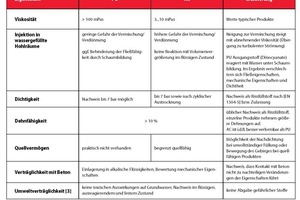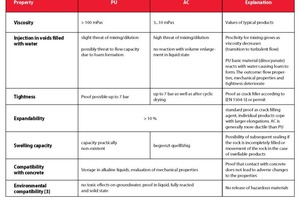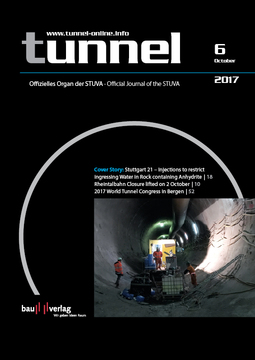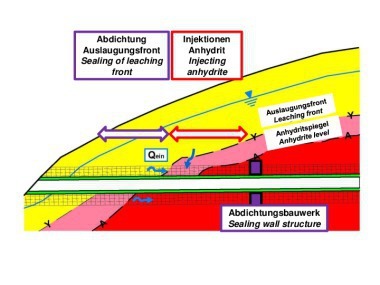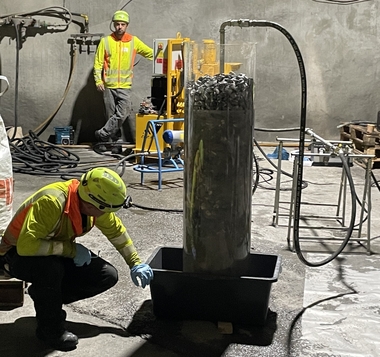Proof of the Suitability of Injection Agents for Sealing Rock Injections
In connection with tunnelling injections are executed with different goals in mind. An important objective in this case is sealing the rock immediately bordering the tunnel with the aim of preventing water being conducted along the tunnel shell. This is of particular significance if layers of rock which carry water as well as layers sensitive to it have to be penetrated, because the water must be prevented from being transported to the sensitive layers.
Injections for sealing rock are also needed if the tunnel is partly produced with a closed invert and partly with an open invert or if waterproofing structures are required to prevent longitudinal conductivity. This report deals with the suitability of injection agents for the cited purpose. Requirements from other fields of application are not taken into consideration.
1 Injection Agents for waterproofing Rock Grouting
Essentially the same grouting agents can be considered for waterproofing rock injections as for injections aimed at sealing structures or for the transition area between the structure and the subsoil [1]. The fundamental requirements posed on the injection agents are the same for both fields of application:
• Injectibility
• Sealing effect
• Deformability/ductility/swellability
• Compatibility with concrete
• Environmental compatibility
At the same time, the individual requirements must be assessed differently with regard to executing successful injections. Essentially polyurethane resins (PU) and acrylate gels (AC) are suitable for injections for sealing rock. Table 1 contains essential properties partly in addition to the usual proofs [2] required for grouting materials in concrete construction. Basically the application of cement as well as silicate resins is also possible for injections designed to seal rock. On account of the lower deformability of these products they are normally used to reduce flow cross-sections providing that a complete seal is not required.
2 Special Demands on Grouting Agents for Injecting Rock
2.1 General
Injections for sealing rock are accomplished in accordance with DIN EN 12715 [4] in keeping with the principle of grouting without ground displacement by applying the injection methods pore grouting, fissure and contact grouting or void filling. The intention is to fill existing or potential flow paths such as accessible pores, fissures and voids so they are sealed by the grouting agent. On the other hand, the aim is not to displace the existing rock by dint of the grouting pressure or create new flow paths by force.
Grouting without displacing the subsoil calls for the grouting pressure to be restricted to an extent, which precludes undesired reactions on the part of the rock such as deformations, the creation or enlargement of fissures. Owing to the interrelationship between grouting pressure, viscosity of the grouting agent and extent of the injection, technical as well as economic aspects are of significance for the choice of grouting agent.
Essentially grouting agents on a polyurethane as well as an acrylate basis are both highly suitable for injections for scheduled or subsequent sealing on account of their material and processing characteristics. The initial liquid grouting agent is injected into the pore system of the rock via drill holes, into cracks, joints or inhomogeneities, where it sets, thus expanding to seal and fill the existing intermediate gaps. These grouting agents are being applied increasingly in conjunction with tunnelling projects, which require the rock to be filled or sealed for a variety of reasons.
This is also the case for the Stuttgart 21 major project, where polyurethanes and acrylate gels are applied to inject the rock in the Feuerbach and Bad Cannstatt tunnels. The geological boundary conditions prevailing in this project only permit the use of polyurethanes for advance sealing injections in order to secure the excavation, whereas the loosening zones around the tunnels have to be sealed by means of acrylate gel. As is shown in the article by Prof. Dr.-Ing. Walter Wittke et al. in this issue a convincing argument exists for applying acrylate gel with its lower viscosity, which enables a sufficient range to be attained with moderate grouting pressure (see Table 1). The low viscosity acrylate gel also permits sealing of only slightly permeable areas. Polyurethane for its part with its higher viscosity is used for injecting the highly permeable gypsum keuper leaching front.
In contrast to conventional structures, the possibilities for subsequent or additional injections in the rock are highly restricted once tunnels have been built. Furthermore, it is also necessary to ensure a life cycle of at least 100 years for the grouting measures to protect against the occurrence of moisture and reliably fend off unexpected effects of the rock on the tunnel structure. On account of the previously mentioned reasons apart from the basic verifications of suitability in keeping with the pertinent codes of practice listed in abridged form in Table 1, proofs of stability and compatibility with the prevailing types of water are necessary – in addition to proof that the applied grouting agents possess a service life of 100 years while remaining adequately functional. A number of the proofs required for these purposes will be examined briefly in the following taking the example of two selected grouting agents.
2.2 Stability
Under the general heading of stability here first and foremost sufficient resistance of the grouting agents against the effects of water, materials contained therein, rock and construction materials is to be understood. The influence of water and alkaline construction materials on the grouting agents is tested within the scope of the test according to DIN EN 1504-5 [2]. However separate tests are needed for further materials dissolved in water. Polyurethane resins admittedly absorb very little water once they have reacted, however here too, changes to essential properties can occur given the influence of any liquids that might be present.
The stability investigations of the acrylate gels are based on the storage of geometrically defined samples in the corresponding liquids. Alterations to the geometry and dimensions are registered and evaluated, if need be changes to the mechanical properties of the pure gel and gel-sand mixes as well.
Numerous stability tests were undertaken at the MFPA Leipzig on an acrylate gel, which was judged suitable for injecting rock, with a stability list for the product resultantly drawn up [5]. When used for grouting rock, the proven stability against waters acting against concrete up to exposure class XA3 and against water containing substantial amounts of sulphates with varying cations are of particular interest. Towards this end, suitable solutions were produced for the local groundwater conditions. The storage tests failed to reveal any negative influence on the gel in the presence of Na, K, Ca and Mg chlorides and sulphates in dissolved state. The acrylate gel did not show any undesired reactions with the stored liquid [6].
A further issue in conjunction with the question of stability is the influence of the grouting agents on construction materials, e.g. on joint strips made of elastomer or plastic. The corresponding tests in the case of most grouting agents are part of the suitability proofs as crack filling material.
2.3 Aging
Durability describes the capacity of a grouting agent to retain its properties throughout its projected service life. Generally speaking the aging of plastics is understood to be the sum of the chemical and physical alterations to a material, which lead to irreversible changes in the material properties during the course of utilisation under concrete boundary conditions and can affect the material’s application in the course of time. The service life applies to the period during which the grouting agent possesses the necessary properties to a sufficient degree (durability), without falling below the required technical minimum requirements due to degradation processes brought on by aging.
Starting with the call for unrestricted functionality for at least 100 years proof is required that the principle properties do not change unacceptably under the boundary conditions in accordance with use of the tunnel structures (such as temperature, where appropriate radiation, mechanical strain, the influence of impacting liquids and rock). In this connection, the aging processes (oxidation, degradation, hydrolysis, post-condensation and/or post-polymerisation) caused through external boundary conditions have to be evaluated regarding their relevance and the possible effects on the grouting agents. This is essentially possible by two methods – by simulating real surrounding conditions during the desired storage period or by means of accelerated investigations, which shorten the impact time to an economic degree, by correspondingly strengthening factors influencing aging.
What is decisive for the service life test is that the examined property possesses a direct relationship with the requirements. In addition, a minimum requirement has to be defined, which indicates the conclusion of serviceability. The simulation of concrete, practice-related boundary conditions admittedly do not permit any accelerated testing of the grouting agent, however it does provide details of the actual service life under real conditions following protracted test periods.
This approach is not applicable for proving a life cycle of 100 years. Nonetheless, tests under real conditions provide information on the durability enabling a pre-selection to be made. The acrylate gel previously referred to in Section 2.2 has been subjected to a permanent alternating storage of water for roughly 18 years, in the case of which each of the test cycles embrace thorough drying in the atmospheric environment and subsequent swelling until a constant weight is attained. After a slight weight loss in the first cycle the samples have displayed drying and swelling behaviour without any loss since then, thus testifying to the unrestricted reversibility of the swelling capacity given unaltered geometrical properties [7].
The available results show real properties although they still do not permit any reliable estimation of the expected service life to be made. An approximation of the actual service life can only be obtained through accelerated investigations, in the case of which aging processes are triggered by the targeted stepping up of the effective boundary conditions (such as e.g. temperature, agents, radiation, pressure). Towards this end, the grouting agents intended for application are exposed to artificial aging given increased temperature and/or storage in water at 60 °C. As the applied grouting agents must also possess minimum strength properties in addition to their sealing properties during their period of use, the change in property is evaluated on the basis of time-related tensile strength.
It can be concluded from the results of the study available so far [7], [9], [10] that the grouting agents that were applied substantially exceed the service life of 100 years under the anticipated boundary conditions.
Literatur/References
[1] Abdichtung von Bauwerken durch Injektion (ABI-Merkblatt), Ausgabe Oktober 2014
[2] DIN EN 1504-5:2013-06: Produkte und Systeme für den Schutz und die Instandsetzung von Betontragwerken – Definitionen, Anforderungen, Qualitätsüberwachung und Beurteilung der Konformität – Teil 5: Injektion von Betonbauteilen;
[3] Muster-Verwaltungsvorschrift Technische Baubestimmungen MVV TB, Ausgabe 2017/1, Anhang 10, Anforderungen an bauliche Anlagen bezüglich der Auswirkungen auf Boden und Gewässer (ABuG)
[4] DIN EN 12715, Ausführung von besonderen geotechnischen Arbeiten (Spezialtiefbau), Injektionen; Stand: 2000-10
[5] Gutachterliche Stellungnahme Nr. GS 5.1/16 - 335: Rubbertite und Rubbertite/Polinit – Acrylatgele zur nachträglichen Abdichtung von Rissen und Zwischenräumen, MFPA Leipzig
[6] MFPA Leipzig: Untersuchungsbericht UB 5.1/14-502, Untersuchung des Kontaktverhaltens von Injektionsharzen auf Acrylatbasis und Anhydritgestein
[7] MFPA Leipzig: Prüfbericht PB 5.1/14-223/16: Untersuchungen zum Alterungsverhalten von PUR‑O‑STOP FS‑L der Fa. TPH Bausysteme GmbH
[8] MFPA Leipzig, Prüfbericht Nr. PB 5.1/14-441: Verhalten des Acrylatgels Rubbertite der Fa. TPH Bausysteme GmbH nach etwa 16-jähriger Wasserwechsellagerung und Auslagerung im Erdreich
[9] C. Prase: Alterungsverhalten eines Injektionsstoffes auf Polyurethanbasis, experimentelle Untersuchung zur Lebensdauerabschätzung, Masterarbeit an der HTWK Leipzig 2016
[10] Sachse: Alterungsverhalten von Injektionsstoffen unter Wärmeeinwirkung, Projektarbeit an der MFPA Leipzig in Zusammenarbeit mit der HTWK Leipzig, 2017

